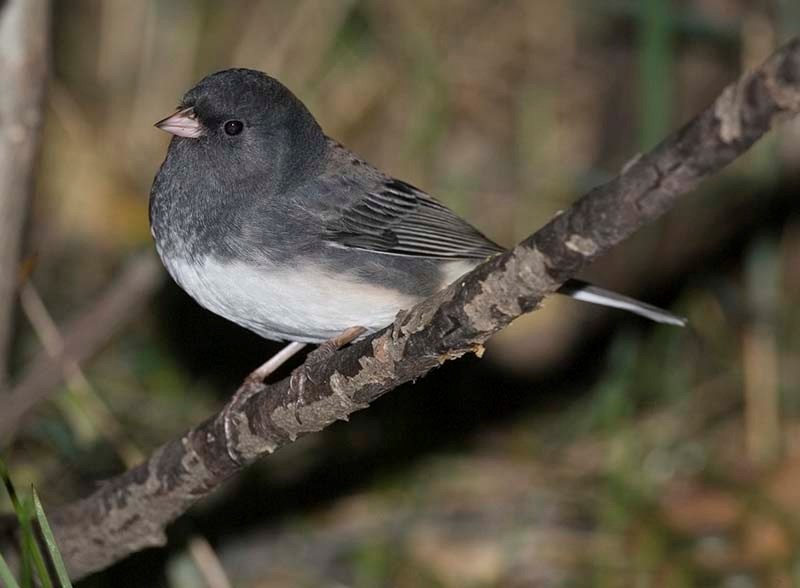There was a time a few summers ago when I was mystified by a mysterious, dark-eyed beauty.
It all started when I heard this fantastically loud, musical, trilling song near my house. You could hear it from about 50 paces away, and it was always from roughly the same spot. It was a call like none I’d ever heard before, and I couldn’t figure out its source.
It took me about a week to spot that tiny little black bird atop the tip of a four-storey tall spruce tree, and another month before I found a birder who could identify it: the dark-eyed junco, a bird that I have now seen a grand total of two times in my life.
Apparently I’m blind, since they’re one of the most common birds in North America. Local birder Peter Demulder says he spots their nests along local trails every year, and ran into a live one just last week. “I was just walking the trail and it was walking in front of me.”
The dark-eyed junco is a sparrow-shaped bird with a dark head and top, white throat and bottom, pink bill, black-looking eyes and white outer tail feathers, reports ARKive.org.
While there are about 16 sub-species of junco in North America, just four show up in Alberta, and just one of those tends to hang around St. Albert.
The ones around St. Albert are known as slate-coloured juncos, Demulder says, as they have a wet-slate coloured head, a dry-slate body, and bellies like bright winter snow.
You’ll occasionally get Oregon juncos here as well, notes Royal Alberta Museum ornithologist Jocelyn Hudon. These are more common towards the Rockies, and have a black hood and a reddish back. Down south, you might spot the pink-sided (blue-grey with pinkish flanks) or the white-wing (two white wing-bars) varieties.
“Those differences seem to have evolved very recently,” adds Hudon, who studies these birds, within the last 10,000 years following the last glacial period. Researchers are now working to figure out what caused this sudden shift.
During the spring and summer, juncos will often stand atop high trees singing a high-pitched, trilling song to attract mates. “The name my daughter used to call it was the ‘telephone’ bird,” Demulder says, as it sounded a bit like the telephone ringers of old.
The chipping sparrow sounds very similar to it, he notes, but tends to be lower pitched. You might also hear a junco make a clicking noise when disturbed or irritated.
The dark-eyed junco gets its name from its eye colour, which looks very black.
But that’s actually a trick of the light, Hudon notes. “It’s actually a dark, brick-red colour.” The irises have red pigmentation, but as there’s nothing in the eyes to reflect the resulting red colour back to us, the eyes look black unless we’re super-close to them.
The junco has been the subject of much research, Hudon says, and has helped scientists figure out how birds know when to migrate.
Researcher used to think birds judged when to fly south based on temperature, Hudon says. University of Alberta researcher William Rowan proved that it was actually due to day length in the 1920s by using lights to influence the amount of daylight a group of juncos received. Eventually, he was able to get them to sing as if it was spring despite it being almost -40 C outside in the middle of winter, suggesting that day-length influenced sexual behaviours such as migration.
This was only a partial proof, reports the U of A, as he couldn’t tell which way the birds flew once released. The smoking gun came in 1931 when he managed to get a bunch of crows to migrate north instead of south after a similar experiment.
While juncos normally migrate south for the winter, a fair number of them will overwinter in St. Albert, Demulder says. (About 48 were spotted in the 2012 St. Albert Christmas Bird Count.)
I hear these fellows all the time, but it’s been years since I’ve actually seen a dark-eyed junco. Maybe this winter I’ll get lucky.
Dark-eyed junco
Name: <br />Junco hyemalis.<br /><br />Appearance:<br />Medium-sized sparrow with variable appearance. Around St. Albert, usually has a slate grey head and back, white belly, pink bill, dark red-black eyes and white feathers on the edge of its tail.<br /><br />Commonly seen:<br />Hopping about trails or underneath birdfeeders, standing on treetops singing. <br /><br />Occasionally confused with:<br />Chirping sparrows, which sound similar.<br /><br />Fun fact: <br />Often called snowbirds in the eastern U.S. as they arrive there during winter and vanish come spring.
Wild St. Albert
Like wildlife? So do we! Every second Wednesday the Gazette profiles a reasonably common wild creature in the St. Albert region. Birds, beasts, bugs, fish … so long as it's alive and kicking, we’ll feature it. <br /><br />Got a creature you’d like to see profiled? Send your suggestions to [email protected].




